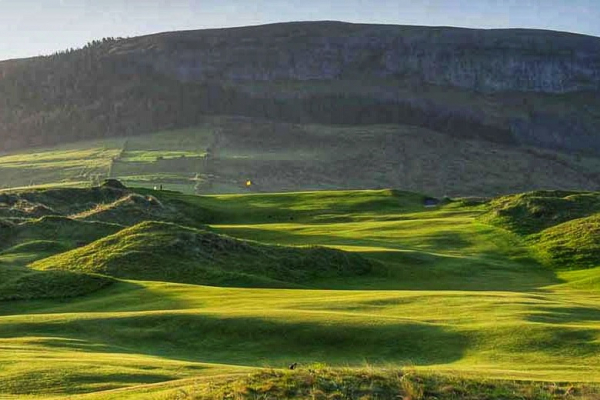Ireland’s Top Hidden Gems
It’s tough to define a hidden gem and there is definitely a gray area between the big names courses and those out of the public eye. Note that we have omitted some well-known “second-tier” courses like Dooks, Ardglass, Donegal (Murvagh), and Castlerock, as we hope to shine a light on some of our favorite tracks in Ireland that are well off the beaten path.
Narin & Portnoo (Northwest Ireland)

Narin and Portnoo is tucked away in the far northwest corner of Ireland and for most of its 90+ years of existence it has been out of mind and out of site of golf travelers, to say the least. That all changed recently when world-renowned architect Gil Hanse was brought in to enhance the simple elegance of the rugged coastal gem. Our advice is to get there soon before the masses get word of what he has done.
Strandhill (Northwest Ireland)

The varied layout at Strandhill has a lot of character. The course sits in tight confines in the shadow of Knocknarea Mountain along Strandhill Beach and its quirky design is a thrill a minute. The wise golfer will call on all shots at their disposal using a range of different clubs to successfully traverse the tricky doglegs and severely undulating terrain.
Portsalon (Northwest Ireland)

With a history that dates to 1891 and a prime location alongside the sandy beaches of Ballymastocker Bay on Ireland’s stunning north coast, it’s amazing a course like Portsalon makes it onto a list like this. The opening shoreside stretch is awesome, especially the 2nd with view sweeping views across Lough Swilly, while the closing inland holes add interesting variety. Pat Ruddy was brought in at the turn of the century to lengthen and modernize the original layout but thankfully the club has always retained its charm.
Concra Wood (East Coast)

It’s tough for a parkland layout to gain traction in a nation known for its seaside links, but it’s still surprising that Concra Wood isn’t better known. Designers Christy O’Connor Junior and Senior routed the course through a spectacular, wooded setting down to the shores of Lough Muckno and the views stretch across the Monaghan Drumlins to the Mourne Mountains on a clear day.
Ballybunion’s Cashen Course (Southwest Ireland)

Although overshadowed by the neighboring Old Course, the Cashen Course stands on its own among Ireland’s best courses. The topography of the Cashen is dramatic, with tight fairways cut between the tallest dunes at Ballybunion (even bigger than the Old Course!). In fact, designer Robert Trent Jones called the Cashen the finest piece of links land he had ever seen. To overlook it would be a mistake.
Cruit Island (Northwest Ireland)

Often regarded among the World’s greatest 9-hole courses, Cruit Island is Ireland’s most remote course and probably its most dramatic as well. The course is characterized by massive elevation changes and expansive views across to Owey Island but the highlight is probably the short 6th, which is perched precariously on the clifftops teetering on the edge of the Atlantic.
Dingle (Southwest Ireland)

Dingle Golf Links, known locally as Ceann Sibeal, is actually the westernmost course in all of Europe, and its secluded location at the tip of the breathtakingly beautiful Dingle Peninsula feels like the edge of the world. You may hear the native Irish language between locals but a warm welcome awaits visitors to this awe-inspiring, rugged coastal links.
Cork (Southwest Ireland)

Alister MacKenzie had a knack for picking fantastic properties with which to work, and the beautiful stretch of Little Island shoreline along Cork’s Inner Harbour on which the 130-year-old Cork Golf Club sits is definitely no exception. Most memorable are the quarry holes, which begin at the short 6th and uniquely cut into and across ancient limestone.
Kirkistown Castle (Northern Ireland)

The influence of designer James Braid is apparent throughout Kirkistown, as deep revetted bunkers, raised greens, and firm, fast fairways closely resemble the traditional links courses in Braid’s home country of Scotland. The card measures just over 6,000 yards but it’s all you want on a windy day, especially the frightening uphill 10th which has ruined many good scores.
Seapoint (East Coast)

Seapoint has a few things keeping it from prominence: it’s relatively new for an Irish links (having opened in 1993), it’s overshadowed by neighboring County Louth, and it’s sometimes docked for an inland stretch that is more heathland than linksland. It’s tough to argue, though, that the closing stretch along the Irish Sea is pure links and pure magic.






